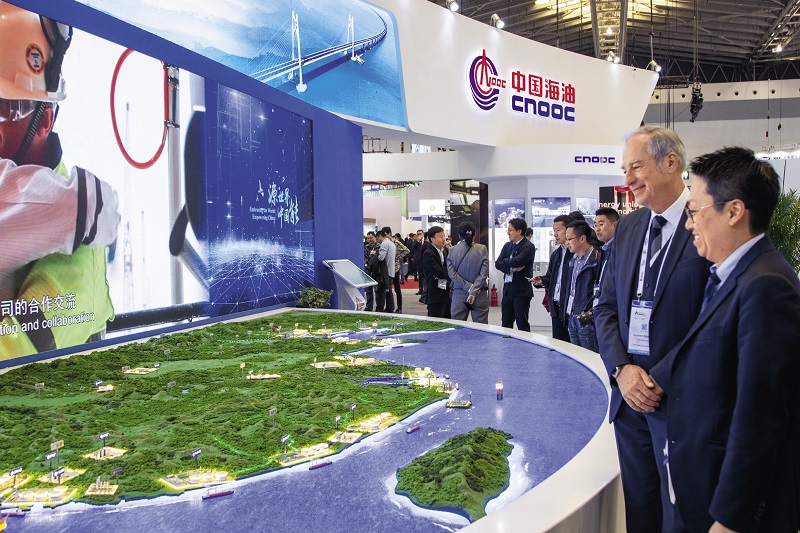
CNOOC’s booth at the 19th International LNG Conference 2019 in Shanghai.
The first carbon-neutral liquefied natural gas (LNG) cargo of China National Offshore Oil Corp. (CNOOC) destined for Hong Kong Special Administrative Region of China was delivered on September 29, 2021 to the Dapeng terminal in Guangdong. A key feature of the shipment was that the carbon emissions associated with the entire value chain were offset by way of financing a forest carbon sink project in China’s Jiangxi Province and other projects, according to Zhong Xiang, vice director of the Commercial Business of CNOOC’s Gas Power Co.
Natural gas is a low-carbon fossil fuel. It emits half the greenhouse gas (GHG) and less than one-10th of the air pollutants of coal during the energy generating process. With its great ecological value, LNG helps with climate change mitigation. “Carbon neutrality is the global trend. Carbon-neutral production processes will be more acceptable to the market and will also be in greater demand,” Zhu Zihan, a researcher at the Research Institute of Beijing Gas Group Co., told ChinAfrica.
A New Solution for the Industry
To achieve carbon neutrality, businesses must buy “carbon credits” to offset GHG emissions across the whole value chain including production, liquefaction, shipping, regasification, and end use. This is accomplished through emission reduction programs certified by Verified Carbon Standard (VCS), which include renewable energy generation, reforestation, and energy conservation, among others.
China has surpassed Japan as the world’s largest LNG importer, with a volume of 101.92 million tons in 2020. China’s natural gas industry is rapidly developing, and imports are increasing.
In June 2020, Gas Power, China’s largest LNG importer, bought two cargoes of carbon-neutral LNG from Shell. It was the first transaction of its kind in the Chinese mainland at the time. The two enterprises were able to achieve carbon neutrality across the whole industrial chain by using carbon credits from nature-based initiatives in Qinghai Province and Xinjiang Uygur Autonomous Region. As a result, carbon emissions were offset by planting trees.
Shell, TotalEnergies, and BP are among the major corporations in the industry that have stated their desire to become carbon neutral by 2050. As a result, they play a significant part in the global market. TotalEnergies delivered its first shipment of carbon-neutral LNG to CNOOC on September 29, 2020. The carbon footprint of the shipments, according to the French firm, was offset by VCS emission credits obtained from funding two vital initiatives. The first is the Guyuan wind power project in Hebei Province, which seeks to cut emissions from north China’s coal-fired power plants, and the second is the Kariba REDD+ project, which is involved in the preservation of Zimbabwe’s forests.
VCS is now the most widely used worldwide standard for projects and programs aimed at reducing GHG emissions and absorption. On October 18, 2021, an LNG tanker docked at CNOOC’s terminal in Zhejiang Province to unload the first carbon-neutral LNG cargo to be offset by a national standard: China Certified Emission Reduction (CCER). To further promote it in China, CNOOC and Shell decided to use the Chinese standard to offset GHG emissions, which is conducive to the globalization of Chinese-style carbon credit standards. “Today, carbon neutrality has risen to the level of a national strategy. Carbon-neutral LNG is part of an important solution for the country’s energy security,” Zhu said.
A Strong Potential
LNG that is carbon-neutral is not a new notion in the world. Shell, Tokyo Gas of Japan, the world’s second largest LNG importer, and the Republic of Korea’s GS Energy inked the first worldwide agreements more than two years ago. Since then, such agreements have multiplied, mostly in Asian nations including Japan, the Republic of Korea, Singapore, China, and India. This Asian trend, according to energy consulting company Wood Mackenzie, reflects the sector’s efforts to lower carbon dioxide emissions, owing to more stringent scrutiny of LNG’s carbon impact.
However, Zhu believes that carbon-neutral LNG, which is a climate asset, would have to overcome a number of challenges. “Companies achieve it on their own. So, its acceptance is currently limited in the domestic market,” Zhu said. If a company buys it, it means that it is also taking on social responsibility, rather than just seeking profits. It needs to engage in more promotion, explanation, and communication to highlight the social aspect. In addition, along the whole chain of the natural gas from production to consumption, the largest segment of carbon emissions comes from the end use of the gas, which accounts for at least two-thirds of the emissions over the entire cycle. In this sense, the end users should also pay part of the costs for carbon neutrality. Despite high awareness of green and low-carbon lifestyles in China, the new type of LNG is still unknown to consumers.
According to Zhu, carbon-neutral LNG should be given special consideration. A demonstration park, for example, may be built based on this notion, with the results driving change. “Japan has a buyer’s group that offers them additional bargaining power with overseas suppliers. That is an experience from which we can learn,” the researcher clarified. “Carbon-neutral LNG can play a significant role in China’s green growth, and it also has favorable perception among the policymakers,” he explained.